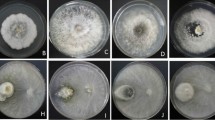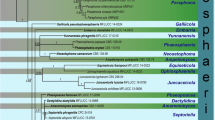Abstract
About 63 fungal endophytic isolates were separated from rhizomes of Paris polyphylla var. yunnanensis, which is a traditional medicinal plant mainly distributed in China. The isolates were characterized and grouped based on the culture characteristics and the morphology of colony growth and conidia. Eleven representative ones were selected for further taxonomical identification. Five genera namely Fusarium, Gliocladiopsis, Gliomastix, Aspergillus and Cylindrocarpon were identified on the basis of their morphological characterizations. Of them, the most frequent genus was Fusarium (i.e. Ppf1, Ppf3 and Ppf14). Their ITS-rDNA sequences were compared with those available in the GeneBank databases to obtain the closest related species by BLAST analysis as well as to analyze their phylogenetic affiliation. The isolates were identified as Gliocladiopsis irregularis (Ppf2), Plectosphaerella cucumerina (Ppf4), Padospora sp. (Ppf6), Gliomastix murorum var. murorum (Ppf7), Aspergillus fumigatus (Ppf9), Pichia guilliermondii (Ppf10), Neonectria radicicola (anamorph: Cylindrocarpon) (Ppf12) and one uncultured mycorrhizal ascomycete (Ppf13) separately based on their morphological and molecular features. The molecular characters of the endophytic fungi were basically coincident with their morphology. The broad diversity and taxonomic spectrum were exhibited by the endophytic fungi from P. polyphylla var. yunnanensis.

Similar content being viewed by others
References
Ainsworth GC, Sparrow FK, Sussman AS (1973) The fungi, an advanced treatise. Edition Vol IV(A), a taxonomic review with keys ascomycetes and fungi imperfecti. Academic Press, New York
Barnett HL, Hunter BB (1972) Illustrate genera of imperfect fungi. Burgess Publishing Co., Minnesota
Hata K, Futai K (1995) Endophytic fungi associated healthy pine needles infested by the pine needle gall midge, Thecodiplosis japonensis. Can J Bot 73:384–390
Kimura M (1980) A simple method for estimating evolutionary rate of base substitutions through comparative studies of nucleotide sequences. J Mol Evol 16:111–120
Kumar S, Tamura K, Nei M (2004) MEGA3: integrated software for molecular evolutionary genetics analysis and sequence alignment. Brief Bioinform 5:150–163
Naruya S, Masatoshi N (1987) The neighbor-joining method: a new method for reconstructing phylogenetic trees. Mol Biol Evol 4:406–425
Photita W, Taylor PWJ, Ford R et al (2005) Morphological and molecular characterization of Colletotrichum species from herbaceous plants in Thailand. Fungal Divers 18:117–133
Raeder U, Broda P (1985) Rapid preparation of DNA from filamentous fungi. Lett Appl Microbiol 1:17–20
Strobel GA (2003) Endophytes as sources of bioactive products. Microbes Infect 5:535–544
Tan RX, Zou WX (2001) Endophytes: a rich source of functional metabolites. Nat Prod Rep 18:488–459
Thompson JD, Higgins DG, Gibson TJ et al (1994) Improving the sensitivity of progressive multiple alignment through sequence weighting, positions-specific gap penalties and weight matrix choice. Nucleic Acids Res 22:4673–4680
White TJ, Bruns T, Lee S et al (1990) Amplification and direct sequencing of fungal ribosomal RNA genes for phylogenetics. In: Innis MA, Gelfand DH, Sninsky JJ et al (eds) PCR protocols: a guide to methods and applications. Academic Press, New York
Acknowledgements
This work was co-financed by the grants from the Hi-Tech Research and Development Program of China (No. 2006AA10Z423) and National Natural Science Foundation of China (No. 30470038). The authors are grateful to Prof. Shilin Wang of Kunming Institute of Botany in Chinese Academy of Sciences for plant material collection and identification.
Author information
Authors and Affiliations
Corresponding author
Rights and permissions
About this article
Cite this article
Li, J., Zhao, J., Xu, L. et al. Endophytic fungi from rhizomes of Paris polyphylla var. yunnanensis . World J Microbiol Biotechnol 24, 733–737 (2008). https://doi.org/10.1007/s11274-007-9531-3
Received:
Accepted:
Published:
Issue Date:
DOI: https://doi.org/10.1007/s11274-007-9531-3




